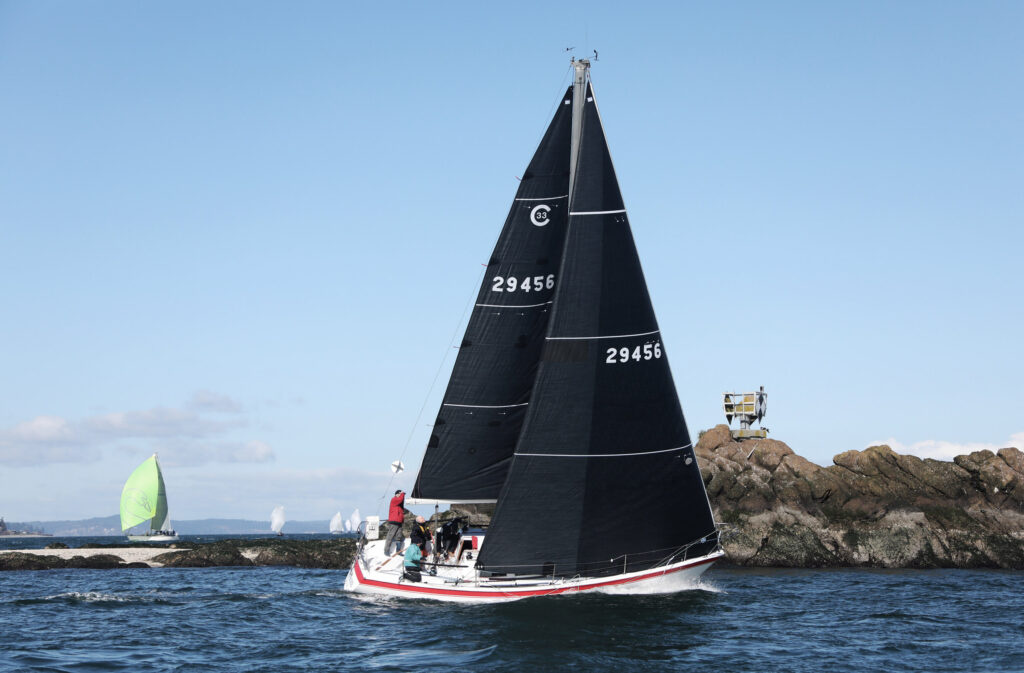
It is officially spring in the Pacific Northwest and while we certainly have a few more weeks of cold weather ahead of us, we have finally kicked off the official 2022 sailing calendar.
The first race of the Corinthian Yacht Club’s Center Sound Series, the Blakely Rock Race does just what it says, taking racers on a course around the iconic rocks at the entrance of Eagle Harbor. Being the first and shortest of the three-race series, the racecourse runs the fleet north to a set mark off the oil tanks near Edmonds and then turns southward to the rocks themselves and then simply back to the start and finish line off Shilshole Bay Marina.
Crossing both the shipping lanes and ferry lanes right at the mouth of Eagle Harbor can make for potentially nerve-racking interactions; the very large commercial traffic can throw a wrench in even the most seasoned tactician’s plans for the day. This year, 85 boats took part, which posed its own tactical challenges. But with a strong turnout for the area’s opening race of the season, there were no complaints to be had.
Saturday’s forecast called for a blustery day in the high teens with the possibility of the low twenties, which was in keeping with the last few years that saw the race held in high winds. The morning of the race was somewhat confusing as the breeze had subsided, and a pleasant 10-knot northerly wind was gently blowing evenly across the Sound. The anticipated rolling swell from an evening of building breeze was nowhere to be found, and a surprisingly calm sea state greeted racers as they left the marina.
Racing got underway a little after 10 a.m. with the higher-rated, slower boats starting first and making their way northward in the increasingly steady breeze. The eyes of skippers and tacticians were glued to the early fleets to see which way boats were going out, and if there were any tips on what side of the course was to be favored. Thus, with a relatively short starting line, it was a game of weighing the benefits of starting at the favored end of the line versus clear air and a clean upwind lane right out of the gate. With the steady breeze firmly established across the Sound, an early clearing tack was not necessarily a death sentence; keeping the boat moving up the course as efficiently as possible was on everyone’s mind.
As the clusters of boats from each start began to spread out across the course, faster boats in the later starts overtook the early starts, and the game plan became clear: It was all about speed and sailing minimal distance around the course. With the layers of boats overtaking one another, clear air was at a premium. On the faster boats, it was a constant calculation of whether to foot and power through to the leeward of a slow boat or take two potential painful tacks to step up a lane for clear air. On the other side of the coin, the smaller boats had to decide whether to stick it out in a larger boat’s dirt until they pass or take a down-speed step up the ladder to clear their air. All in all, plenty of complicated fleet tactics at play as the fleet worked its way to the top mark. As is tradition, the traffic problem amplified at the rounding as all 85 boats tried to round and set their spinnakers at essentially the same time. With a decent amount of yelling and a small amount of fending off by at least two boats, things settled into the kite run down to the rocks.
The road map to the final leg back to the finish line can be etched into the rocks themselves. Traditionally, you try to round as high and tight to the rocks as you practically can and then stay on port tack all the way until you reach the beach under the Magnolia Bluff. From here, it’s a couple of tacks to capitalize on the starboard tack lift as you near the West Point lighthouse and then tacking into Shilshole Bay as deep as needed to head for the finish boat. Most boats found themselves following this playbook, but those who didn’t had the clear air needed to tack more frequently to work their way back towards the finish.
The race wrapped up for the day with all boats finishing the course, and things are looking like they are back on track for a full-fledged racing season in Puget Sound. After all the times were calculated, there were certainly two stand-out performances in the overall results with the J-122 Grace taking the top spot and Joe Grieser and Alex Simanis taking second place on the recently rebuilt Bonita 27 Pell Mell. Both boats absolutely rocketed off the start line and were nearly halfway around the course before the big boats began to overtake them. Certainly, these are two boats to keep on an eye during the rest of the spring series.


